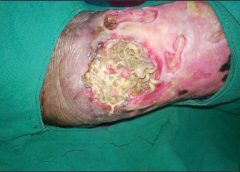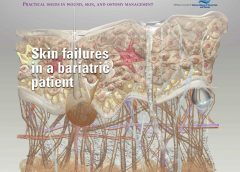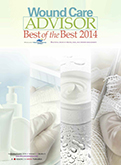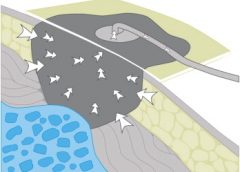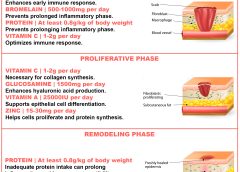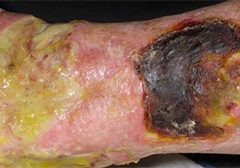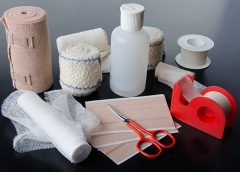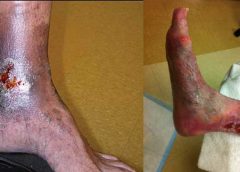Diabetes carries high economic burden
According to a study published in Diabetes Care, the economic burden associated with diagnosed diabetes (all ages) and undiagnosed diabetes, gestational diabetes, and prediabetes (adults) exceeded $322 billion in 2012, amounting to an economic burden exceeding $1,000 for each American. (more…)
Read More
By Gail Rogers Hebert, MS, RN, CWCN, WCC, DWC, OMS, LNHA
The World Health Organization defines palliative care as “an approach that improves the quality of life of patients and their families facing the problem associated with life-threatening illness, through the prevention and relief of suffering by means of early identification and impeccable assessment and treatment of pain and other problems, physical, psychosocial and spiritual.” (more…)
Read More
Our Editors want your feedback, opinions and ideas!
Your input is vital in assuring that Wound Care Advisor is a valuable resource to your practice. Please consider sending an electronic Letter to the Editor to share your opinion, nursing experience and continue the conversation about nursing care.
Important: If your Letter to the Editor is chosen for publication, we would like to include your credentials and City, State. It would also be very helpful if you give us your contact information should we have any questions. Please be assured that we will keep your contact information confidential.
If you’re interested in sharing your input, fill out the form below. By submitting your Letter to the Editor you agree to possible publication in either a print or electronic future issue of Wound Care Advisor.
Read More
Here is a list of valuable ostomy resources, some suggested by our colleagues who follow Wound Care Advisor on Twitter.
United Ostomy Association of America
The United Ostomy Association of America provides comprehensive resources for patients, including information about the types of ostomies and issues related to nutrition, sexuality, and travel. Much of the information is also available in Spanish and can be downloaded for free from the website. (more…)
Read More
By Laura L. Barry, MBA, MMsc, and Maureen Sirois, MSN, RN, CEN, ANP
Why is it that some things don’t bother us, while other things catapult us from an emotional 0 to 60 mph in a heartbeat? We all know what it feels like when someone says or does something that gets our juices flowing. We feel it in our bodies, emotions, and mood. We have an overwhelming urge to react. We may express it in words at the time or take our frustrations out later on someone else. It just doesn’t feel good. We want to explode, set the record straight. (more…)
Read More
By Jeri Lundgren, BSN, RN, PHN, CWS, CWCN
As a wound care nurse, do you feel the weight of the world on your shoulders when trying to implement a pressure ulcer prevention program? Many staff members think it’s up to the wound care nurse alone to implement the program. However, a successful program requires involvement from all staff and is a 24/7 endeavor. Here’s how to do it. (more…)
Read More
By Nancy Morgan, RN, BSN, MBA, WOC, WCC, DWC, OMS
Each issue, Apple Bites brings you a tool you can apply in your daily practice.
Measurement of wounds is an important component of wound assessment and provides baseline measurements, enables monitoring of healing rates, and helps distinguish among wounds that are static, deteriorating, or improving. All alterations in skin integrity, including those caused by ulcers, venous ulcers, arterial ulcers, neuropathic ulcers, incision lines, grafts, donor sites, abscesses, and rashes should be measured when they’re discovered and at intervals thereafter, based on institutional policy. (more…)
Read More
Radiation and lymphedema
Radiation therapy doesn’t increase the incidence of lymphedema in patients with node-negative breast cancer, according to research presented at the American Society for Radiation Oncology’s 56th Annual Meeting held this fall. (more…)
Read More
By Ronald A. Sherman, MD; Sharon Mendez, RN, CWS; and Catherine McMillan, BA
Note From the Editor: This is the second of two articles on maggot therapy. The first article appeared in our July/August 2014 issue, Read part 1 here.
Whether your practice is an acute-care setting, a clinic, home care, or elsewhere, maggot debridement therapy (MDT) can prove to be a useful tool in wound care. But setting up any new program can meet resistance—and if you seek to establish a maggot therapy program, expect to meet significant resistance. By arming yourself in advance, you can achieve your goal more easily. This article covers all the bases to help you get your maggot therapy program off the ground. (more…)
Read More
By Hedy Badolato, RD, CSR, CNSC; Denise Dacey, RD, CDE; Kim Stevens, BSN, RN, CCRN; Jen Fox, BSN, RN, CCRN; Connie Johnson, MSN, RN, WCC, LLE, OMS, DAPWCA; Hatim Youssef, DO, FCCP; and Scott Sinner, MD, FACP
Despite the healthcare team’s best efforts, not all hospitalizations go smoothly. This article describes the case of an obese patient who underwent bariatric surgery. After a 62-day hospital stay, during which a multidisciplinary team collaborated to deliver the best care possible, he died. Although the outcome certainly wasn’t what we wanted, we’d like to share his story to raise awareness of the challenges of caring for bariatric patients. (more…)
Read More

